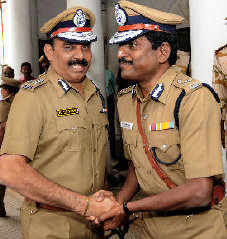Mustache Pay & Other Idiosyncrasies of India
Policemen must have mustaches.

Policemen in Chennai
In India, the policemen were required to grow mustaches because it was considered to make one look more authoritative. I was doubtful of this and looked it up. Turns out my ex wasn’t too far off. Check out this article from BBC News entitled “Indian police given moustache pay” and I quote:
Police in a district in India’s Madhya Pradesh state are being paid to grow moustaches because bosses believe it makes them command more respect.
But that’s in a different state in India so I decided to refine my search to Tamil Nadu and that’s when I found this article from the Times of India entitled A moustache divide.
“Coming back to moustaches, south India must be the only place outside Iraq and some other Arab kingdoms where a moustache is visible on so many male faces. But a moustache in south India doesn’t denote status, movement, or sub-culture. In Iraq, men grew moustaches to look like Saddam Hussein. In south India, however, just about every adult male has foliage on his upper lip, whether he’s a tycoon or coolie.”
My ex had a mustache when he lived in India, as does his father, friends and as soon as his younger brother can grow one, I am sure he will have one too…
Chicken 65
Just recently I was talking to my ex and he told me about eating a dish called “Chicken 65”. I have been trying to educate myself on Indian cuisine since we have been together these past 3 years and had not yet come across this dish.
“What is Chicken 65?” I ask my ex.
“It is spicy dish made from chickens that are 65 days old.” he replies.
“What???” I found this to be quite absurd so I decided to look it up. I found a lot of recipes and this entry in Wikipedia.
While the name “Chicken 65” is universally used to refer to the dish, there are many different stories for how the name came about. It is generally acknowledged that no one knows which (if any) of these anecdotal theories are correct
- Chicken 65 is alleged to be a dish introduced in 1965 by the Buhari Hotel restaurant in Chennai. They also offer Chicken 78, Chicken 82 and Chicken 90, introduced in 1978, 1982 and 1990 respectively.
- The dish is said to require 65 days to prepare the marinade, but this is unlikely for reasons of freshness and flavor.
- One account claims that the dish emerged as a simple meal solution for Indian soldiers in 1965.
- Another account claims that it is a dish containing 65 chilli peppers devised by an enterprising hotelier.
- The name is also claimed to relate to a requirement for the meat to be from 65-day-old chickens.
- Yet another source claims that northern Indian army soldiers frequented a military canteen in Chennai. Its menus were written in Tamil, the local language. As most soldiers could not read Tamil, they made their choice by citing the number of the dish on the menu. The dish’s popularity spread among the soldiers by word of mouth. They’d simply ask for “number 65”; soon, the dish became known officially as “Chicken 65”.
That sounds about right — depending on who you ask, you’ll get a different reason for the name but the bottom line for Indians is that it tastes good!
Indian music — Bollywood and Kollywood

Kollywood actress
Most people have heard of “Bollywood” but in case you don’t really know what it means, here’s Wikipedia’s definition and Bollywood’s official site is here.
Bollywood is the informal term popularly used for the Hindi-language film industry based in Mumbai (formerly known as Bombay), Maharashtra, India. The term is often incorrectly used to refer to the whole of Indian cinema; it is only a part of the total Indian film industry, which includes other production centers producing films in regional languages. Bollywood is the largest film producer in India and one of the largest centers of film production in the world.
So large in fact, whereas Hollywood produces an average of 500 films per year, Bollywood produces more than 1000 and grosses more than Hollywood. Kollywood, on the other hand, is India’s second large center of film production and it is based in Tamil Nadu. producing films primarily in the native language of that region, Tamil.
Tamil cinema (also known as the Kollywood, the Tamil film industry, the Cinema of Tamil Nadu or the Chennai film industry) is the film industry based in Chennai, Tamil Nadu, India, dedicated to the production of feature films in the Tamil language. …Tamil cinema is known for being India’s second largest film industry in terms of films produced, revenue and worldwide distribution, with audiences mainly including people from the four southern Indian states of Tamil Nadu, Kerala, Andhra Pradesh, and Karnataka, placing the industry among the largest in the world.

A R Rahman
I was told by my ex that all Indian films, especially those produced in Kollywood, were required to have at least six songs in them. Having watched numerous Tamil films, of a wide variety of subjects and styles, I can attest that this appears to be true. For a Western viewer it is hard not to find it comical when one minute there is an intense dramatic moment and the next they all break out into song and dance. If you have ever seen Slumdog Millionaire, the scene at the end where all the actors since and dance is an ode to this tradition.
The songs that are performed in these movies are called “Filmi“
Filmi (is Indian popular music as written and performed for Indian cinema. Music directors make up the main body of composers; the songs are performed by playback singers and it makes up 72% of the music sales in India.
So in India, the majority of the popular music is basically lip-synced by actors and the actual performers or composers remain anonymous. However, one such composer, A R Rahman, who is from Chennai, has broken through this tradition and become a star in his own right, even on an international level. For Tamils, A R Rahman is a hometown boy made good and all of India is proud of him, especially those from Tamil Nadu. You might not know the name but I guarantee you have heard his music. He was the composer for the Slumdog Millionaire soundtrack for which he received two Academy Awards.
The Moral Police

Logo for Chennai Police
When my ex described India, it was always with great reverence and love, but when he would describe Chennai, it was with love and bitterness. That is because Tamil Nadu, at least when My ex lived there, was the most conservative, strict state in all of India. The police in that state, and most obviously in its capital of Chennai, did not just enforce the law but what they defined as a moral code of conduct.
When my ex was young, the way of life he described, was the way it really was. Some of the things he told me were how men and women who were not married or direct relatives, could not be seen in public together, that the police would stop them, ask for identification and if the couple was not married or related, the police would then arrest them and contact relatives. This means no going out to eat, to the movies or of course to a hotel. Hard to believe for a Westerner but it really happened as described in these sources:
The policeman’s argument was that a married woman was sitting next to another man. “You are a Tamil woman. How can you sit with another man?” he questioned. Then came his one-liner: “This is Tamil Nadu, not America!” His threats during the 45 minutes he spend humiliating the two persons, included calling up the woman’s husband to the police station and telling him that he saw his wife in a compromising position with the man. The sub-inspector even tried to take the woman in a police jeep with no woman constable. His parting shot: “Take up the matter wherever you want.” The same day, a senior high court lawyer in his mid-40s was subjected to similar treatment when he was coming out of the Triplicane railway station with his wife. The policeman wanted to know who the woman was.
- Disturbing trend of moral ‘policing’ in Chennai
- Unmarried couples to stay in chennai resort?
- Chennai’s Moral Police
The harrassment also extended to ones style of dress or hair. Men who wore their hair long were often arrested and hassled, treated as criminals. Thankfully, it appears there has been some loosening up, some progress to a more open society. I can not find an article more recent than 2010 so I think things have changed. Plus, some things like men with long hair have not been an issue at all.
I’m sure as I learn more about India I will discover more idiosyncrasies as it seems to be inherent in the very fiber of the country. A country so diverse with so many languages, religions, backgrounds and preferences is bound to be a study in contrast — beautiful and terrible is how I have heard it described. Someday soon I hope to see for myself.
